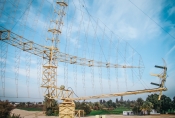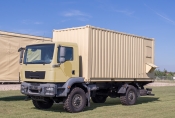P-14ML
- Home
- Radar systems
- P-14ML
The radar equipment cabin is fully upgraded. Metric band is preserved, however the number of working frequencies is increased from 4 to 200, the capability of instantaneous electronic frequency agility is added. Radar transmitter and receiver feature solid-state components only. The transmitter has a modular design and provides “soft-failure” redundancy: failure of individual module leads only to partial reduction in power.
Antenna-mast assembly is equipped with new asynchronous motors controlled by variable-frequency drives.
P-14ML remains a two-dimensional system and is used to find azimuth and range. Altitude can be obtained by interfacing upgraded height-finding radars, in this case radar and height-finders operate as a 3D radar complex. Parameters of transmitted signal as well as parameters of signal processing after reception can be set at the operator workstation, secondary processing and tracking are performed at the remote workstation. Both workstations are installed in the equipment cabin in standard configuration.
As an option, ground interrogator can be controlled from the radar with the assignment of aircraft state identification status.
All air situation is automatically recorded with playback capability in passive and interactive modes.
P-14ML radar features efficient protection against pulse interference and active jamming. The operator workstation graphically presents noise to the operator allowing for visual assessment of jamming and interference at given frequency and bearing of a jammer. Jamming protection is achieved through expansion of the dynamic range of the signal processor and capability of quick electronic frequency shifting. Passive interference is rejected through digital adaptive MTI and generation of clutter map.
Equipment of P-14ML can be installed on a semitrailer or in two standard sea containers mounted on concrete base or on a vehicle.
|
Parameter
|
Before upgrade |
After upgrade |
|
Range of working frequencies |
170-190 MHz |
160-200 MHz |
|
Frequency agility: |
|
|
|
electromechanical |
electronic |
|
4 fixed frequencies |
200 kHz |
|
n/a |
10 kHz |
|
Types of transmitted probing pulses: |
|
|
|
10 µs |
10 µs |
|
|
|
|
13-bit |
|
13 × 10 µs |
|
42 bit |
|
42 × 10 µs |
|
Transmitter pulse power / signal energy |
700 kW / 7 J |
30 kW / 12 J |
|
Capability of instant probing signal power and structure changes |
Not implemented |
Implemented |
|
Detection range for a target with RCS of 2.5 m2: |
|
|
|
- |
2,7 km |
|
30 km |
37 km |
|
85 km |
105 km |
|
110 km |
130 km |
|
185 km |
220 km |
|
290 km |
400 km |
|
Detection accuracy: |
|
|
|
1000 m |
270 m |
|
0.8° |
0.4° |
|
Resolution: |
|
|
|
3500 m |
1600 m |
|
8° |
8° |
|
Range of MTI |
- |
0 - 500 km |
|
Clutter suppression ratio |
- |
> 40 dB |
|
Dynamic range of receiver and digital signal processor |
- |
up to 100 dB |
|
Automatic control of upgraded height-finders |
- |
Implemented |
|
Number of controlled height-finders |
- |
up to 2 |
|
Start-up time |
8 min |
3 min |
|
Power consumption |
60 kW |
40 kW |







